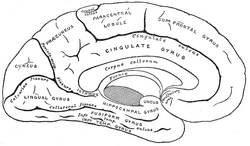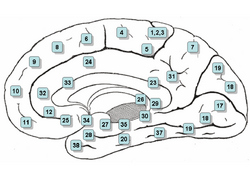No edit summary |
No edit summary |
||
| Line 28: | Line 28: | ||
[[Anterior cingulate cortex]] can further be divided in the [[perigenual anterior cingulate cortex]] and [[midcingulate cortex]]. |
[[Anterior cingulate cortex]] can further be divided in the [[perigenual anterior cingulate cortex]] and [[midcingulate cortex]]. |
||
| + | |||
| + | ==History== |
||
| + | [[Cingulum]] means belt in Latin. The name was likely chosen because this cortex, in great part, surrounds the [[corpus callosum]]. Cingulate is an adjective (cingularis or cingulatus). |
||
| + | The cingulate cortex is a part of the "grand lobe limbique" of [[Paul Broca|Broca (1898)]] that consisted (in addition to the olfactory part, which is no more considered there today) of a superior cingulate part, supracallosal; and an inferior hippocampic part, infracallosal. The limbic cortex was separated from the remainder of the cortex by Broca for two reasons: first that it is not convoluted, and second that the gyri are directed parasagitally (contrary to the transverse gyrification). Since the parasagittal gyrification is observed in non-primate species, the limbic lobe was thus declared to be "bestial". As with other parts of the cortex, there have been and continue to be discrepancies concerning boundaries and naming. [[Brodmann (1909)]], a student of [[C. and O.Vogt]], who worked on cercopithecus (and not much in human (Bailey and von Bonin)), elaborated a system of numeration that had unfortunately no typological logics (1, 2 and 3 are sensory, 4 is motor, 5 is parietal, 6 is premotor and 7 is again parietal!). Area 25 was even not placed by him in the same place in the human brain. Area 24 (anterior) was distinguished from 23 (posterior) on the basis that it was agranular. More recently, the typographical von Economo's system was adopted by Bailey and von Bonin. Simple typographical naming should be preferred, for evident heuristic purposes. |
||
| + | |||
==External links== |
==External links== |
||
Revision as of 21:27, 16 December 2007
Assessment |
Biopsychology |
Comparative |
Cognitive |
Developmental |
Language |
Individual differences |
Personality |
Philosophy |
Social |
Methods |
Statistics |
Clinical |
Educational |
Industrial |
Professional items |
World psychology |
Biological: Behavioural genetics · Evolutionary psychology · Neuroanatomy · Neurochemistry · Neuroendocrinology · Neuroscience · Psychoneuroimmunology · Physiological Psychology · Psychopharmacology (Index, Outline)
| Brain: Cingulate cortex | ||
|---|---|---|
| Medial surface of left cerebral hemisphere. | ||
| Medial surface. | ||
| Latin | gyrus cingulatus | |
| Gray's | subject #189 825 | |
| Part of | ||
| Components | ||
| Artery | ||
| Vein | ||
| BrainInfo/UW | hier-141 | |
| MeSH | A08.186.211.577.330 | |
The cingulate cortex is part of the brain and situated roughly in the middle of the cortex.
Based on cytoarchitectonics it can be divided into the Brodmann areas 23, 24, 26, 29, 30, 31 and 32. The areas 26, 29 and 30 are usually referred to as the retrospenial areas.
Cingulate cortex can also be differentiated based on its thalamic connections1: Anterior cingulate cortex receives primarily from the midlline and intralaminar nuclei and posterior cingulate cortex receives mainly from the anterior thalamic nuclei.
Anterior cingulate cortex can further be divided in the perigenual anterior cingulate cortex and midcingulate cortex.
History
Cingulum means belt in Latin. The name was likely chosen because this cortex, in great part, surrounds the corpus callosum. Cingulate is an adjective (cingularis or cingulatus). The cingulate cortex is a part of the "grand lobe limbique" of Broca (1898) that consisted (in addition to the olfactory part, which is no more considered there today) of a superior cingulate part, supracallosal; and an inferior hippocampic part, infracallosal. The limbic cortex was separated from the remainder of the cortex by Broca for two reasons: first that it is not convoluted, and second that the gyri are directed parasagitally (contrary to the transverse gyrification). Since the parasagittal gyrification is observed in non-primate species, the limbic lobe was thus declared to be "bestial". As with other parts of the cortex, there have been and continue to be discrepancies concerning boundaries and naming. Brodmann (1909), a student of C. and O.Vogt, who worked on cercopithecus (and not much in human (Bailey and von Bonin)), elaborated a system of numeration that had unfortunately no typological logics (1, 2 and 3 are sensory, 4 is motor, 5 is parietal, 6 is premotor and 7 is again parietal!). Area 25 was even not placed by him in the same place in the human brain. Area 24 (anterior) was distinguished from 23 (posterior) on the basis that it was agranular. More recently, the typographical von Economo's system was adopted by Bailey and von Bonin. Simple typographical naming should be preferred, for evident heuristic purposes.
External links
- Four Regions of Cingulate Cortex and Disease Vulnerability, Brent A. Vogt.
- BrainMaps at UCDavis Cingulate
- Mapping 'self' and 'other' in the brain
References
- Vogt BA, Rosene DL, Pandya DN, Science 204:205+
| This page uses Creative Commons Licensed content from Wikipedia (view authors). |

